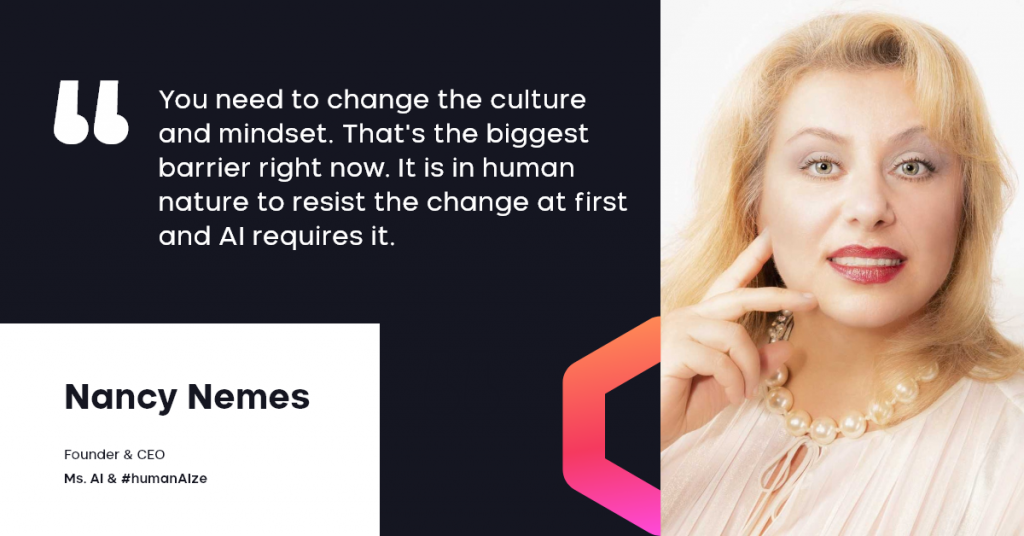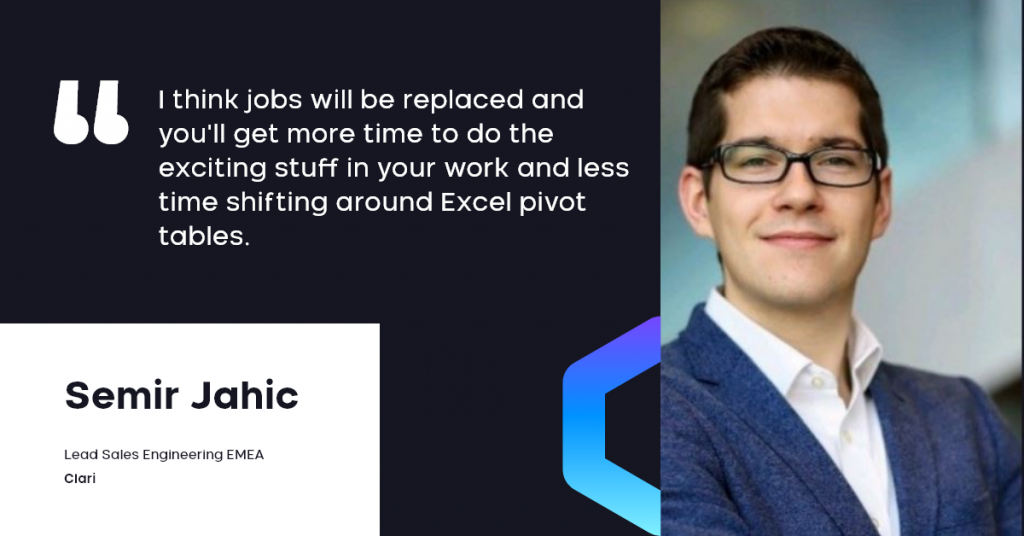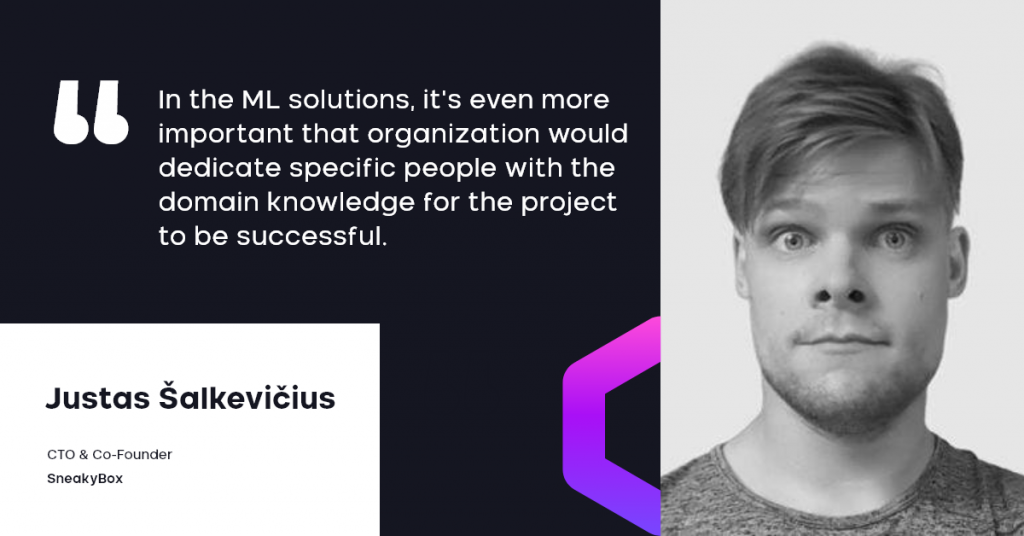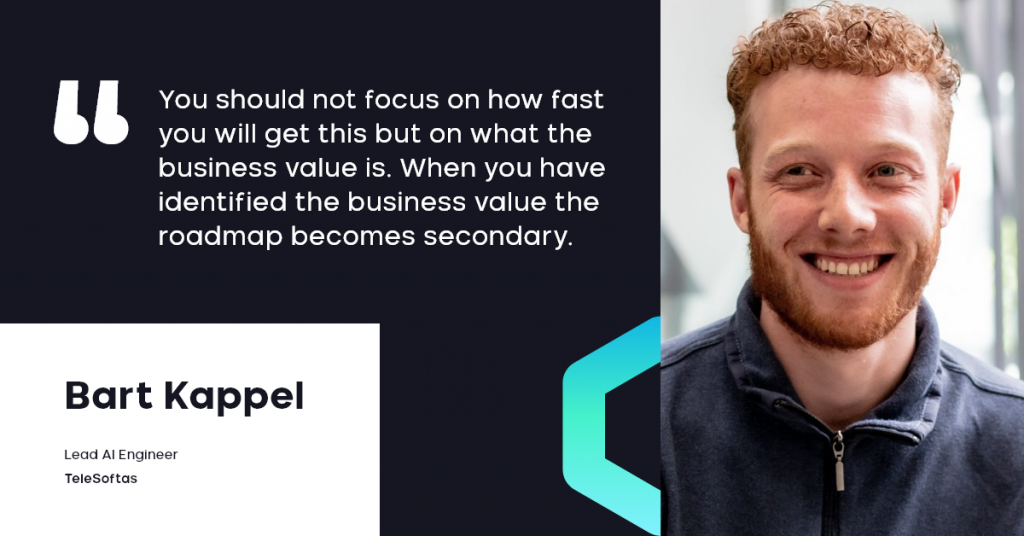How AI is helping businesses grow? How to successfully integrate it into your services and what are the factors that prevent companies or entire governmental institutions from adopting this technology?
We are more than happy to present to you the consolidated in-depth answers to these and many more questions discussed in our webinar AI: Is Your Business Ready for It? by our panel guests and experts of the field:
- Nancy Nemes – Founder & Chief Enthusiasm Officer of Ms. AI and #humanAIze, Former global leader @ Google and Microsoft, Member of the EU Alliance for Artificial Intelligence.
- Semir Jahic – Lead Sales Engineering EMEA @ Clari, Lecturer on AI, innovation @ UCL, Former group leader of AI solutions sales for EMEA @SalesForce, Former Senior Analyst @ Accenture.
- Justas Šalkevičius – CTO @ SneakyBox, Ph.D. in Machine learning.
- Bart Kappel – Lead AI Engineer @ TeleSoftas, MA in Robotics.
Let’s dive!
Q: What do you think are the key components or blockers for the companies to start implementing AI?

Nancy: It all really starts with the mindset. Companies must learn to make the shift from C load work to interdisciplinary collaboration and co-creation. Secondly, we have to move from leader/executive based decision making to database decision-making. You need to change the culture and mindset. That’s the biggest barrier right now. It is in human nature to first resist the change and AI requires it.
The second barrier is fear. The fear that our word will be jeopardized, that human labor will become redundant to the machines. The third one which is very common to all businesses is the talent that we do not have enough of. This is really the biggest problem for businesses. The skills that are needed for AI right now are not taught in schools early enough so they are not part of the education systems. We are making some progress but we need to start it early on.
Lastly, companies struggle to prepare a proper AI strategy and define their business value of digital transformation. It’s not about the digitalization of existing processes, it’s about transforming the way you do business so it is crucial to first identify those business objectives. To gather data and know what to do with it. Only then you should go for implementing AI. A lot of businesses are struggling with that.
Q: Have you seen AI changing the work process of teams and companies?

Semir: Absolutely. AI was this very big trend but nobody knew what it really was and everybody wanted to be educated on it. When we go from hype to realizing it this will be a massive transformation and transformation will come in changes in jobs and in realizing the value of AI. I don’t think that jobs will be completely replaced. I think jobs will be replaced and you’ll get more time to do the exciting stuff in your work and less time shifting around Excel pivot tables.
AI will become embedded into the workflows of people. It won’t be an add-on that we need on top. It will be just a part of it. Just like you don’t question what kind of server your Netflix subscription ‘sits’ on.
When you look at people in sales operations currently they’re so busy with the pandemic, Will the sales hit the targets we’re planning? Will we achieve our goals or not? Historically they were working in spreadsheets, analyzing data, crunching stuff back and forth every day. New information comes in and now that kind of platform that we built allows them to just have that analysis automated and they will spend more time interpreting it and critically thinking about it. That’s sort of where the skill gap is really important as well as what Nancy has mentioned – educating young students to learn to think critically and creatively. That’s a crucial point in understanding how AI can be leveraged to generate real value.
Q: What is the dream team when implementing AI solutions? How much domain knowledge do the engineers have to know to work on a project?

Justas: It is really important for product owners to be involved. For example, in software development in agile, we really liked how the customer of the solution being developed was a part that we were driving the refinements from. In the ML solutions, it’s even more important that organization would dedicate specific people with the domain knowledge for the project to be successful. So I believe that the dream team would comprise of good experts coming from the organization itself that would have a good understanding of what kind of data the business already uses in driving their decisions.
Q: What do you think are the benefits of forming an AI team inside and outside of the organization?
Nancy: If you really are an AI company you know what to do, meaning you have your in-house specialists. If you are a company that wants to transform the business then you may want to start with the support that will allow you to try it first. In that case, setting up a central AI team is a good place to start. It is also very important to have your in-house specialists as leaders of AI projects. For that to function, you need to form an interdisciplinary team of engineers. If it’s in-house you need to connect the dots. If it’s outside of the house, someone needs to come and facilitate that connection of thoughts. It’s not just having data scientists. Of course, you need to have business development, unique sales, and marketing specialists too. You even need anthropologists to look at this from different points of view depending on what you do. An anthropologist can give you insights and bring that cultural lens from an anthropologist’s point of view to help you to make sense of what your data means.
You need to have business development, unique sales, and marketing specialists too. You even need anthropologists to look at this from different points of view depending on what you do.
Nancy Nemes
Q: How do you sell the idea of implementing an expensive AI solution to the boss? The investors? Company? Is it even worth doing so?
Semir: That’s something that I’ve faced many times, be it in Salesforce or now at Clari. I think that those people who didn’t believe in cloud and internet computing twenty years ago are now catching up. Just as Justas mentioned, you need a domain expert, a domain person who is also tech-savvy. That person is the Holy Grail of the company you need. No external company will be able to tell you more about your business than that kind of person. But if that person also understands the concepts of AI and can ask the question “What if we could analyze our reviews and have sentiment and maybe send the client a nice voucher if they’re unhappy just to improve that small process?” – it changes the game, nothing revolutionary, no crazy robots or autonomous vehicles, just one simple thing. That’s a competitive advantage and over time you will do more and more and it will become embedded. As this becomes more embedded and these champions are translating the possibilities and the potential into what it means for their business, the value will become very apparent for the top leaders in the company.
I always ask clients to look at the problem they are facing first and the strategy they want to pursue as a business and what’s keeping them from achieving it. I start with this question and then start translating how technology can help enable their strategy. Technology is not a standalone thing in the story, the customer is the hero and technology enables them to achieve their vision.
Q: What is a realistic roadmap of adopting AI?

Bart: This is always hard to determine. AI is never done and when you deploy the solution you need to re-evaluate it. Business requirements change, it’s a continuous process that’s why it’s so important to create an AI strategy within the company. It really depends on the business case and how you build your team. You should not focus on how fast I will get this but on what the business value is. When you have identified the business value the roadmap becomes secondary. It all depends on a problem, how you implement it, organizational structure. Semir has perfectly described it – you should not ask how long it takes, you should ask what do I want and what does it bring to my business because those questions are way more interesting than “Will I have it next year or will I have it in two years?”.
Q: Should one put simple automation on hold before an AI strategy is developed? Does one need to think big? Can you start small?
Semir: You have to have big audacious goals but you have to find ways to do small and quick wins. You try changing everything at once, you will lose momentum. So start small but always have a big vision in mind.
Nancy: I love to work in terms of knowing if this business is improving people’s lives, is my solution really impacting millions of people. That’s how the big ones became big. If it’s Google or Microsoft or Facebook, they have always dreamed about impacting the lives of millions which they do. This big dream is something that helps you create unicorns and that’s a long-term one.
Considering implementing an AI solution into your own business? We’ve prepared a special AI Adoption Workbook that will help you identify the main roadblocks as well as the fundamentals for AI adoption in your company.
Watch the video recording of the panel discussion where AI experts share their journeys, opinions, and experiences in adopting AI:
